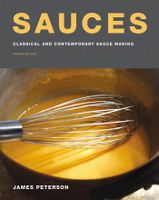Advertisement
Purées and Puréethickened Sauces
Appears in
Published 1991
Purées of vegetables, nuts, legumes, and sometimes fruits are used either as sauces in themselves or to thicken and flavor more complex sauces or cooking liquids. Tomato and sorrel sauces are examples of purées that provide the base and essential character of the sauce; the purée functions as both a thickener and the primary flavor. Purées can also be used to finish sauces, or to lightly thicken braising liquids or roasting juices without distracting from the cooking liquid’s intrinsic flavor. Because most purées, depending on the amount and type of starch they contain, are less efficient emulsifiers than hydrocolloids or purified starches such as flour, cornstarch, or arrowroot, they give body to a sauce by dispersing large amounts of insoluble components—often proteins or cellulose-related compounds—into the liquid medium. For this reason sauces based on or thickened with vegetable purées usually have a matte appearance rather than the smooth, transparent look associated with starch-, hydrocolloid-, and butter-thickened sauces.

